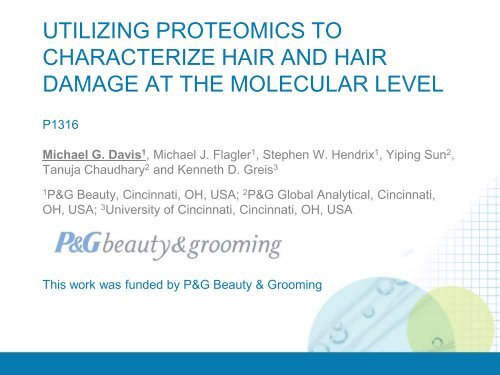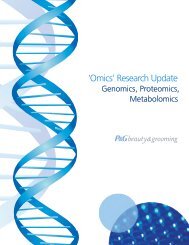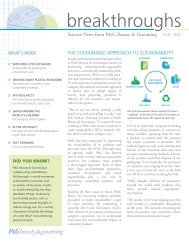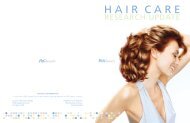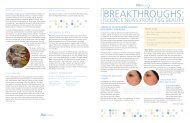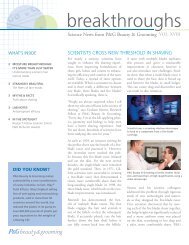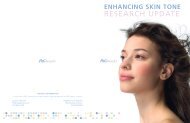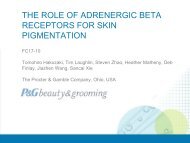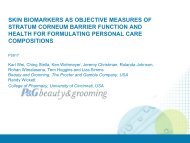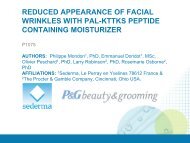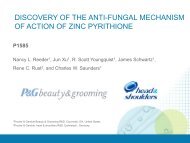utilizing proteomics to characterize hair and hair damage
utilizing proteomics to characterize hair and hair damage
utilizing proteomics to characterize hair and hair damage
You also want an ePaper? Increase the reach of your titles
YUMPU automatically turns print PDFs into web optimized ePapers that Google loves.
UTILIZING PROTEOMICS TO<br />
CHARACTERIZE HAIR AND HAIR<br />
DAMAGE AT THE MOLECULAR LEVEL<br />
P1316<br />
Michael G. Davis 1 , Michael J. Flagler 1 , Stephen W. Hendrix 1 , Yiping Sun 2 ,<br />
Tanuja Chaudhary 2 <strong>and</strong> Kenneth D. Greis 3<br />
1<br />
P&G Beauty, Cincinnati, OH, USA; 2 P&G Global Analytical, Cincinnati,<br />
OH, USA; 3 University of Cincinnati, Cincinnati, OH, USA<br />
This work was funded by P&G Beauty & Grooming
INTRODUCTION<br />
• Proteins are the major<br />
structural component<br />
of <strong>hair</strong> (~80-90%)<br />
Component<br />
Protein<br />
Lipid<br />
Protein bound sulfur<br />
Sugars<br />
Ash<br />
Zinc<br />
Melanin (black <strong>hair</strong>)<br />
Approximate content<br />
by dry weight of <strong>hair</strong><br />
91%<br />
4%<br />
4.7%<br />
1.0%<br />
0.5%<br />
200 ppm<br />
4%<br />
Feughelman et al. J. Appl. Polm. Sci., 2002, 83,489.<br />
• Hair is not regenerative after it exits the scalp; therefore, maintaining<br />
proper <strong>hair</strong> architecture at the molecular level is an important hallmark for<br />
a healthy <strong>hair</strong> structure<br />
• Ultimately, proper <strong>hair</strong> protein structure has an important impact on the<br />
cosmetic value of the <strong>hair</strong> shaft
PURPOSE/OBJECTIVES<br />
• Develop new methods <strong>and</strong> models for <strong>hair</strong> shaft<br />
<strong>damage</strong> <strong>and</strong> abnormalities <strong>to</strong> drive new<br />
underst<strong>and</strong>ing at protein level <strong>and</strong> achieve more<br />
sensitive diagnostics for early detection of <strong>damage</strong><br />
• Apply these methods <strong>to</strong> provide insights in<strong>to</strong> how the<br />
molecular structure of the <strong>hair</strong> shaft changes in<br />
response <strong>to</strong> different insults
METHODS<br />
• Traditional Protein loss: 0.2-0.3g <strong>hair</strong> samples (2in. length) were added <strong>to</strong> glass<br />
scintillation vials. Distilled water was added at a ratio of 10:1 (water <strong>to</strong> <strong>hair</strong>). Samples were<br />
shaken for timepoints up <strong>to</strong> 1h at 2,500 rpm on a DVX-2500 Multi-2 Vortexer platform<br />
(VWR). Water extracts were removed from vials <strong>and</strong> protein concentration determined using<br />
the Modified Lowry assay (Pierce).<br />
• Soluble/Insoluble Protein Loss: Samples following traditional protein loss method (above)<br />
were subjected <strong>to</strong> centrifugation at 14,000 rpm <strong>to</strong> separate in<strong>to</strong> soluble/insoluble fractions.<br />
Pelleted material (insoluble) was solubilized in 3M urea, 1M NaOH, 0.06% CHAPS followed<br />
by sonication for 30 min in a Branson B300 sonicating water bath (34KHz). Protein<br />
concentration in soluble/insoluble fractions was determined using the Modified Lowry assay.<br />
The insoluble protein fraction was shown by SEM <strong>to</strong> consist of cuticle, whereas the soluble<br />
fraction was shown by mass spec <strong>to</strong> consist primarily of cortex proteins.<br />
• 2D Gel Electrophoresis: Hair samples pre- <strong>and</strong> post-bleaching (approx. 250mg) were<br />
clipped in<strong>to</strong> 1mm pieces <strong>and</strong> ground in a mortar <strong>and</strong> pestle pre-cooled with liquid nitrogen.<br />
Samples were then extracted in 8M urea, 0.05M Tris, 0.05M DTT, pH 9.3 with end-over-end<br />
mixing for 24h at RT. Following extraction, samples were centrifuged <strong>to</strong> pellet remaining <strong>hair</strong><br />
<strong>and</strong> the soluble fraction was subjected <strong>to</strong> reduction/alkylation <strong>and</strong> dialyzed twice against<br />
distilled water. Following dialysis, samples were mixed 1:1 with 9M Urea, 4% CHAPS,<br />
0.19% SDS, 2% DTT) <strong>and</strong> subjected <strong>to</strong> 15 min of ultrasonic treatment in sonicating water<br />
bath (Branson 2510) <strong>to</strong> resuspend insoluble material. 25µg of protein was loaded in<strong>to</strong><br />
immobilized pH gradient strips (pH 4-7) <strong>and</strong> separated using st<strong>and</strong>ard gel electrophoresis<br />
techniques.<br />
• MALDI-TOF: Water extracts from protein loss method were analyzed by MALDI-TOF/TOF<br />
using st<strong>and</strong>ard pro<strong>to</strong>cols.
METHODS: AN OVERVIEW<br />
MW<br />
pI<br />
2D gels<br />
(of <strong>hair</strong> fiber<br />
sample)<br />
Remove Hair<br />
Soluble Protein Loss<br />
(mainly cortex)<br />
Centrifuge<br />
Pellet<br />
Insoluble Protein Loss<br />
(cuticle)<br />
Spot directly in matrix<br />
Hair Sample<br />
Proteins Eluted<br />
in water<br />
Protein concentration<br />
analyzed<br />
Traditional<br />
Protein Loss<br />
Laser<br />
+<br />
+<br />
+<br />
+<br />
+<br />
MS<br />
MALDI-TOF Mass Spec
RESULTS: ALL HAIR LOSES PROTEIN<br />
• Protein loss can be detected<br />
after just 5 minutes of exposure<br />
<strong>to</strong> water<br />
• Protein loss increases with time<br />
• Chemically <strong>damage</strong>d <strong>hair</strong> loses<br />
more protein than virgin <strong>hair</strong><br />
• Measuring protein loss provides<br />
early detection of <strong>damage</strong>,<br />
before it’s <strong>to</strong>o late<br />
Protein Loss (ug/ml)<br />
350<br />
300<br />
250<br />
200<br />
150<br />
100<br />
50<br />
0<br />
5<br />
10<br />
15<br />
Virgin<br />
Bleached<br />
20<br />
30<br />
40<br />
50<br />
60<br />
5<br />
10<br />
15<br />
20<br />
30<br />
40<br />
50<br />
60<br />
Extraction Time (min)<br />
• Protein loss at 60 minutes is equivalent <strong>to</strong><br />
approx. 0.1% of <strong>to</strong>tal protein from virgin<br />
<strong>hair</strong> <strong>and</strong> 0.4% from bleached <strong>hair</strong><br />
(measured by Modified Lowry assay)
PROTEIN LOSS CORRELATES WITH A MARKER<br />
OF OXIDATIVE DAMAGE<br />
Protein Loss (µg/ml)<br />
1500<br />
1000<br />
500<br />
0<br />
Virgin<br />
MIld Bleach<br />
Heavy Bleach<br />
Hair Type<br />
Description<br />
Cysteic Acid<br />
(units)*<br />
Virgin 26.8<br />
Mild Bleach<br />
(Low Lift)<br />
Heavy Bleach<br />
(High Lift)<br />
53.4<br />
155.3<br />
* A measure of oxidation of surface cystine; measured<br />
by FTIR-ATR.<br />
• Protein Loss, as measured by the Lowry assay, increases with the level of<br />
chemical <strong>damage</strong> <strong>and</strong> correlates with cysteic acid formation, a well known marker<br />
for disulfide breakdown during the bleaching process
NOT ALL HAIR DAMAGE IS THE SAME: DIFFERENTIAL<br />
PROTEINS ARE TARGETED BY DIFFERENT INSULTS<br />
• Separation of soluble <strong>and</strong> insoluble protein loss indicates that bleaching targets predominantly<br />
insoluble proteins (cuticle)<br />
Bleached SOLUBLE<br />
Bleached INSOLUBLE<br />
400<br />
400<br />
Protein Loss (µg/ml)<br />
300<br />
200<br />
100<br />
Protein Loss (µg/ml)<br />
300<br />
200<br />
100<br />
0<br />
0<br />
100<br />
Untreated<br />
Bleached<br />
• Contrarily, exposure of <strong>hair</strong> <strong>to</strong> UV results in loss of almost exclusively soluble proteins (mainly<br />
cortex)<br />
UV SOLUBLE<br />
UV INSOLUBLE<br />
100<br />
Untreated<br />
Bleached<br />
Protein Loss (µg/ml)<br />
50<br />
Protein Loss (µg/ml)<br />
50<br />
0<br />
Untreated<br />
40 hours<br />
0<br />
Untreated<br />
40 hours<br />
Data expressed as Mean + SEM
FRAGMENTATION OF KERATIN 31 IS A BIOMARKER<br />
OF CHEMICAL OXIDATIVE DAMAGE<br />
• MS analysis has shown that keratin 31 is cleaved at the same sites <strong>to</strong> generate the<br />
same peptide fragments every time <strong>hair</strong> is bleached<br />
4700 Reflec<strong>to</strong>r Spec #1 MC[BP = 834.9, 285]<br />
% % Intensity<br />
100<br />
90<br />
80<br />
70<br />
60<br />
50<br />
40<br />
30<br />
20<br />
10<br />
800.2531<br />
824.8885<br />
834.8649<br />
844.3223<br />
839.2581<br />
881.0795<br />
886.2781<br />
916.3190<br />
956.3007<br />
993.8842<br />
987.2777<br />
1036.2694<br />
1177.2810<br />
1278.4763<br />
1405.4078<br />
Virgin Hair<br />
284.6<br />
% %<br />
Intensity<br />
0<br />
799.0 1040.8 1282.6 1524.4 1766.2 2008.0<br />
100<br />
90<br />
80<br />
70<br />
60<br />
50<br />
40<br />
30<br />
20<br />
10<br />
807.1583<br />
850.1978<br />
879.1765<br />
916.1785<br />
969.1910<br />
994.2286<br />
998.1843<br />
1038.1949<br />
1042.2292<br />
4700 Reflec<strong>to</strong>r Spec #1 MC[BP = 994.2, 1100]<br />
1061.1953<br />
1085.2305<br />
1119.2626<br />
1148.1992<br />
1188.2072<br />
1205.1962<br />
1229.2646<br />
1278.4066<br />
1308.2894<br />
Mass (m/z)<br />
Mass (m/z)<br />
Keratin 31<br />
1342.2939<br />
0<br />
799.0 1040.8 1282.6 1524.4 1766.2 2008.0<br />
Mass (m/z)<br />
(m/z)<br />
1387.3157<br />
1430.3033<br />
1470.3545<br />
1499.3151<br />
Bleached Hair<br />
1529.3547<br />
1581.3235<br />
1596.3389<br />
1639.3330<br />
1642.3396<br />
1684.3221<br />
1715.3872<br />
1760.4307<br />
1794.3939<br />
1830.4374<br />
1873.3491<br />
1908.4258<br />
1941.4189<br />
1979.3434<br />
1100.4
FURTHER MS FOLLOWING TRYPTIC<br />
DIGESTION<br />
• Full view of protein loss with tryptic digest for bleached <strong>hair</strong> reveals<br />
more than just keratin 31 but also other structural keratins within the<br />
cortex<br />
Keratin<br />
Fragment<br />
+/- Tryptic<br />
Digest<br />
Acidic/Basic<br />
Cortex/Cuticular Origin<br />
Keratin 31 - Acidic Cortex<br />
Keratin 81 + Basic Cortex<br />
Keratin 33a + Acidic Cortex<br />
Keratin 33b + Acidic Cortex<br />
Keratin 83 + Basic Cortex<br />
Keratin 85 + Basic Both<br />
Keratin 86 + Basic Cortex
2D GELS CONFIRM THE LOSS OF SPECIFIC<br />
PROTEINS WITH BLEACHING<br />
• 2D gels of <strong>hair</strong> samples pre- <strong>and</strong> post-bleaching confirms the loss of<br />
keratins detected in water extracts, as well as keratin-associated proteins<br />
kDa<br />
188<br />
98<br />
4<br />
Keratin 86<br />
Virgin<br />
pH<br />
Keratin 85<br />
Bleached<br />
7 4 pH<br />
7<br />
Keratin 86 (missing)<br />
Keratin 85 (less abundant)<br />
62<br />
49<br />
Keratins<br />
38<br />
28<br />
17<br />
14<br />
6<br />
3<br />
KAP 3.2<br />
KAP 3.3<br />
KAP<br />
3.1<br />
KAP<br />
3.1<br />
Keratin 31<br />
KAP<br />
3.1<br />
KAP 3.2<br />
KAP 3.3<br />
Keratinassociated<br />
proteins (KAPs)<br />
KAP 3.2<br />
KAP 3.3<br />
KAP<br />
3.1<br />
KAP<br />
3.1<br />
Keratin 31<br />
KAP<br />
3.1<br />
KAP 3.2<br />
KAP 3.3<br />
Keratin-associated<br />
proteins (KAPs)<br />
(missing)
SUMMARY<br />
• Protein loss from <strong>hair</strong> increases as a result of <strong>damage</strong> <strong>and</strong> is<br />
consistent with the level of <strong>damage</strong> <strong>to</strong> the <strong>hair</strong> shaft<br />
• Protein loss correlates with other measures of <strong>hair</strong> <strong>damage</strong><br />
• Protein loss can be separated in<strong>to</strong> soluble <strong>and</strong> insoluble<br />
fractions, which differentially segment with particular <strong>damage</strong><br />
insults (UV vs. bleach)<br />
• Specific sites in the protein structure of the <strong>hair</strong> are targeted by<br />
oxidative chemistry resulting in peptide biomarkers of <strong>damage</strong>
CONCLUSIONS<br />
• We have developed robust methods <strong>to</strong> examine <strong>hair</strong> proteins by<br />
using state of the art proteomic techniques<br />
– These techniques have started <strong>to</strong> give us a glimpse in<strong>to</strong> <strong>hair</strong><br />
<strong>damage</strong> at the molecular level by examining the specific<br />
proteins<br />
• These methods provide a better underst<strong>and</strong>ing of structural<br />
changes <strong>to</strong> the <strong>hair</strong> at the molecular level which could lead <strong>to</strong><br />
earlier detection of <strong>damage</strong> <strong>and</strong> new treatment opportunities<br />
• Early intervention could help <strong>to</strong> prevent the negative tactile <strong>and</strong><br />
behavioral changes commonly associated with <strong>hair</strong> coloring


